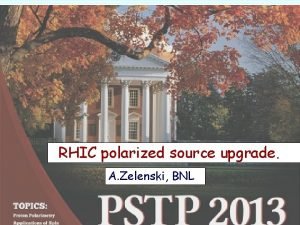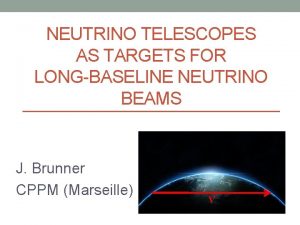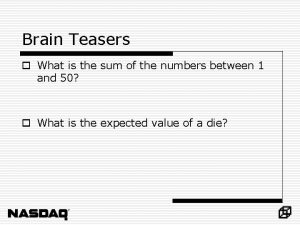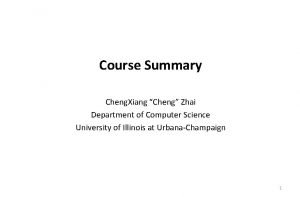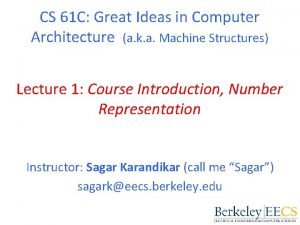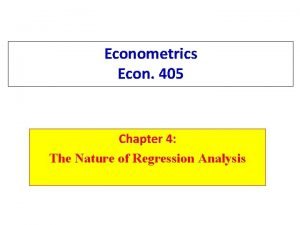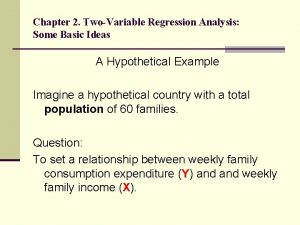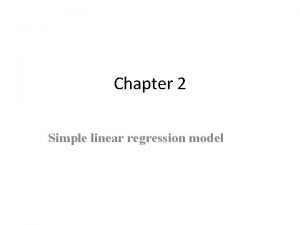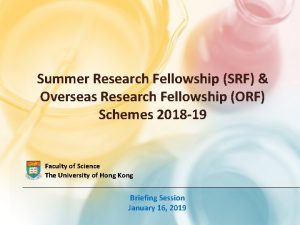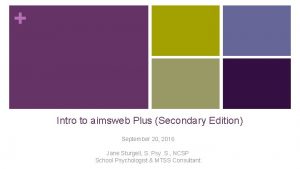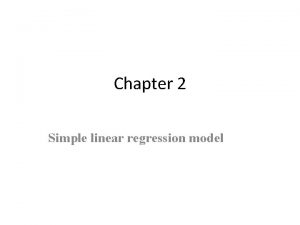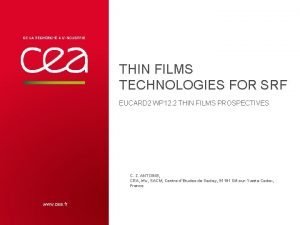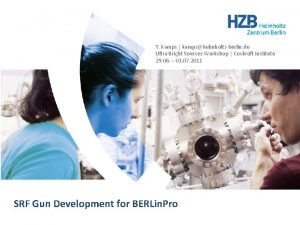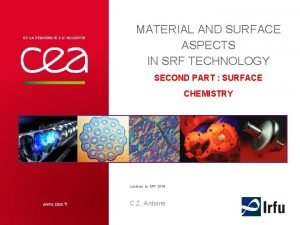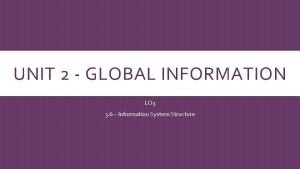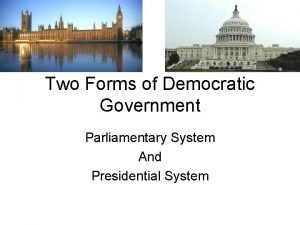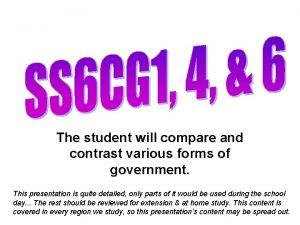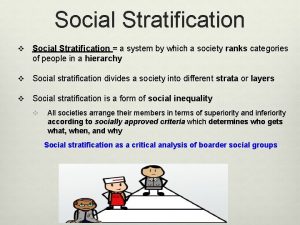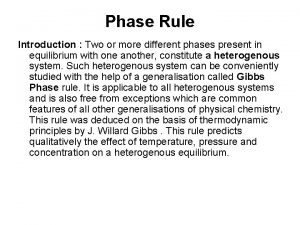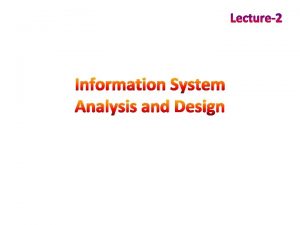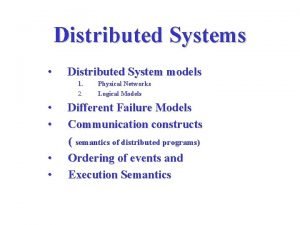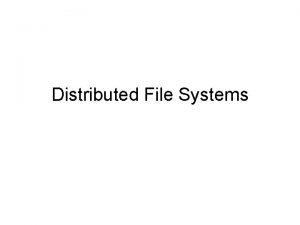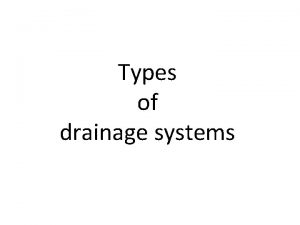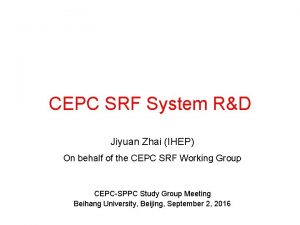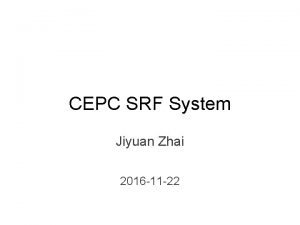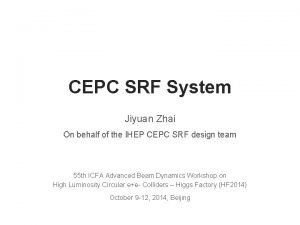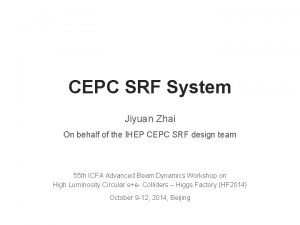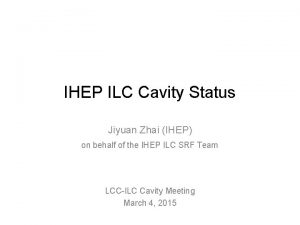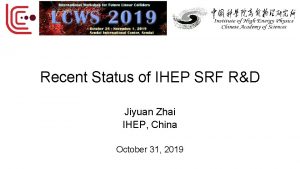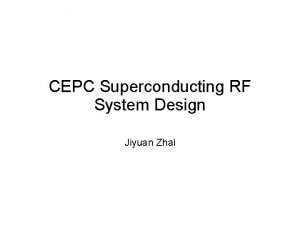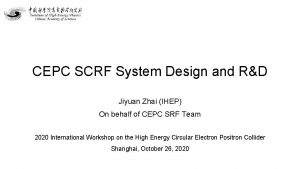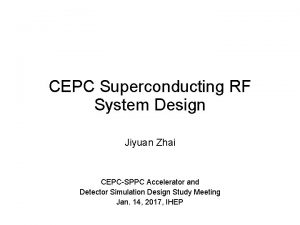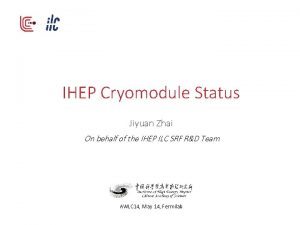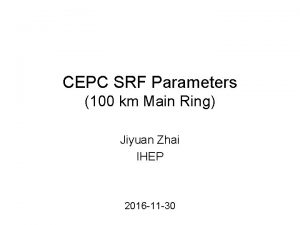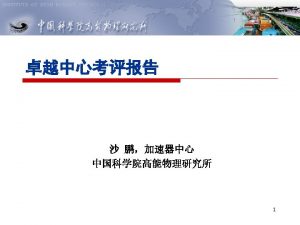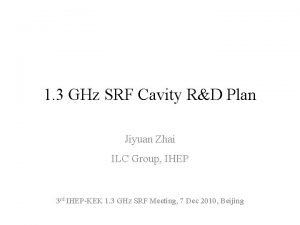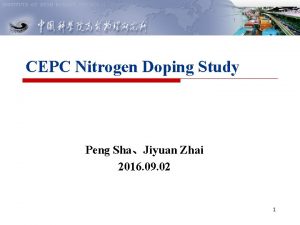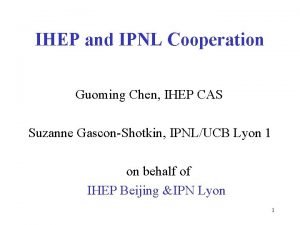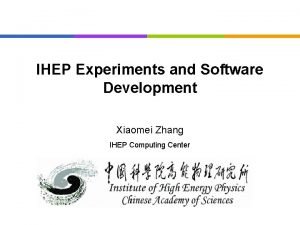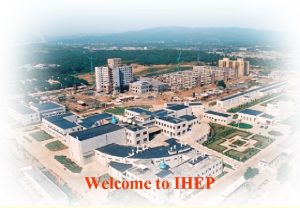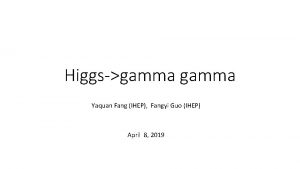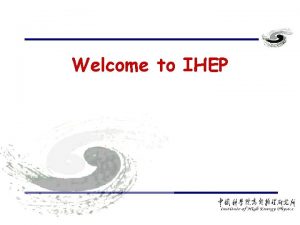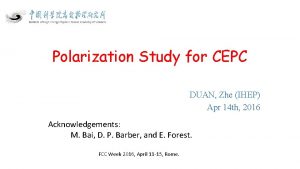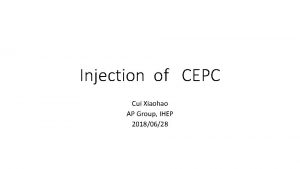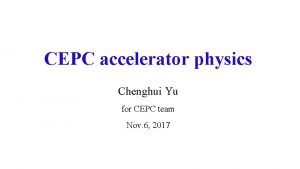CEPC SRF System RD Jiyuan Zhai IHEP On













































- Slides: 45

CEPC SRF System R&D Jiyuan Zhai (IHEP) On behalf of the CEPC SRF Working Group CEPC-SPPC Study Group Meeting Beihang University, Beijing, September 2, 2016

Acknowledgement • Materials from Peng Sha, Hongjuan Zheng, Fanbo Meng, Qiang Ma, Tongming Huang, Zhenghui Mi, Baiqi Liu, Rui Ge, Ruixiong Han etc. 2

Outline 1. CEPC SRF System Design 2. R&D Plan and Status 3. Phase Compensation of Bunch Train 4. Summary 3

CEPC SRF System Design • Main Ring crab waist scheme with H, W & Z luminosity ~ 2 E 34 cm-2 s-1 − Independent of fill pattern and separation scheme, i. e. same SRF System for double ring and partial double ring. . . so as Power Source − Common RF cavity for full double ring − Difference-Frequency (DF) cavity to compensate bunch train phase variation • Main Ring Components − − − Cavity: 2 -cell, standard elliptical shape, Nitrogen-doped Nb at 2 K HOM damper: detachable coaxial HOM coupler, HOM absorber at RT Input coupler: fixed coupling, assemble in cleanroom with cav. Tuner: cavity end, with piezo, cold motor, access port Cryomodule: XFEL/LCLS-II type • Main Ring head-on (single ring) scheme as alternative (Pre-CDR) − similar SRF components, power source and cryogenics • 5 -cell vs 2, similar gradient, higher Q 0 • Booster: TESLA-XFEL-ILC-LCLSII technology (voltage ramp) 4

CEPC Main Ring SRF Parameters (top parameters of D. Wang 20160329) 650 MHz cavity (bulk Nb) Cavity number H (Pre. CDR) H 5 -cell W Z 2 -cell 384 480 160 32 7 3. 65 0. 82 0. 13 Eacc (MV/m) 15. 9 16. 5 11. 1 8. 6 Q 0 @ 2 K 4 E 10 2 E 10 96 80 32 16 / 3. 9 7. 4 12. 9 RF power c. w. / cavity (k. W) 276 215 224* 254* Cavity number per klystron 2 2 / 4 Total klystron number 192 160 HOM power / cav. (k. W) 3. 6 0. 8 0. 4 Total RF power (MW) 106 104 36* 8* Total cav. wall loss @ 4. 5 K eq. (k. W) 22. 2 24 3. 6 0. 4 VRF (Ge. V) Cryomodule number Max. phase shift of 4+4 trains (deg) * include extra power due to coupler mismatch (optimal coupling fixed for Higgs) 5

CEPC SRF Hardware Specifications Hardware Qualification Normal Operation Max. Operation 650 MHz 2 -cell Cavity VT 4 E 10 @ 22 MV/m HT 2 E 10 @ 20 MV/m 2 E 10 @ 16. 5 MV/m 2 E 10 @ 20 MV/m 1. 3 GHz 9 -cell Cavity VT 3 E 10 @ 25 MV/m 2 E 10 @ 20 MV/m 2 E 10 @ 23 MV/m 650 MHz Input Coupler HPT 300 k. W sw < 254 k. W 280 k. W 1. 3 GHz Input Coupler HPT 20 k. W peak, 4 k. W avr. < 15 k. W peak 18 k. W peak 650 MHz HOM Coupler HPT 1 k. W < 0. 2 k. W 1 k. W 650 MHz HOM Absorber HPT 5 k. W < 2 k. W 5 k. W 650 MHz Cryomodule (six 2 -cell cavities) static loss 5 W @ 2 K static loss 8 W @ 2 K static loss 10 W @ 2 K Tuner (MR & Booster) tuning range and resolution 400 k. Hz/1 Hz 200 k. Hz / 1 Hz 400 k. Hz / 1 Hz LLRF (MR & Booster) amp & phase stability 0. 1%, 0. 1 deg amp & phase stability 1%, 1 deg amp & phase stability 0. 1%, 0. 1 deg 6

Outline 1. CEPC SRF System Design 2. R&D Plan and Status 3. Phase Compensation of Bunch Train 4. Summary 7

CEPC SRF R&D Plan towards TDR CDR (2016 -2017), MOST-NKRD (2016 -2021), TDR & CAS-SPRB (2017 -2021? ) MR+BS+DR 2016 2017 2018 2019 2020 2021 Milestone SRF baseline CDR in Jun. , in Sept. N-doping Components fab. & test Components test & impr. Test Module Assembly Horizontal Test, TDR System baseline, physics layout, cost, PS & CR TDR design TDR final Cavity RF design N-doping Mechanical design, fab. Process, VT, HV, Nb 3 Sn Q & Eacc impr. HV Assembly, 1. 3 GHz HT Horizontal Test RF design Mechanical design, fab. High power test Perfromance Improvement Assembly, TDR design Horizontal Test RF design Mechanical design, fab. Low & high power test Perfromance Improvement Assembly, TDR design Horizontal Test Tuner & LLRF CDR design VT impr. Mechanical design Fab. & tes LLRF test VT impr. Assembly, TDR design Horizontal Test Cryomodule Draft 3 D model Mechanical design fabrication cryogenics Assembly, TDR design Horizontal Test SRF facility N-doping, EP T-mapping Kyoto Camera Building#1 Klystron Cryogenics Horizontal Test Input Coupler HOM Damper 8

Main Ring 650 MHz 2 -cell Cavity Design Parameters Value Riris (mm) Alpha (deg) A (mm) B (mm) a (mm) b (mm) L (mm) D (mm) k R/Q (Ω) G (Ω) Ep/Eacc 78 3. 22 94. 4 20. 123 22. 09 115. 3 204. 95 2. 86% 213 284 2. 4 Bp/Eacc [m. T/(MV/m)] 4. 2 kloss (total) [V/p. C] 0. 81 (bunch length 4 mm) Cut-off frequency of TE 11: 1126 beam tube (MHz) TM 01: 1471 9

Qe Limit for MR Coupled-Bunch Instability monopole f (MHz) R/Q (Ω) (2 cell) R/Q* (Ω) (1 cell) Qe (H-LP) Qe (Z-2 cell) Qe (Z-1 cell) TM 011 1165. 536 63. 4 33. 63 4. 74× 104 1. 02× 103 1. 95× 103 TM 020 1384. 302 1. 128 0. 095 2. 24× 106 4. 83× 104 5. 85× 105 dipole f (MHz) Qe (H-LP) Qe (Z-2 cell) Qe (Z-1 cell) TE 111 844. 666 276. 62 131. 03 5. 86× 103 4. 13× 102 8. 72× 102 TM 110 907. 469 414. 84 353. 04 3. 91× 103 2. 75× 102 3. 23× 102 TM 111 1279. 043 ---- 219. 98 ---- 5. 19× 102 TE 121 1468. 139 12. 61 0. 749 1. 29× 105 9. 06× 103 1. 52× 105 R/Q (Ω/m) R/Q** (Ω/m) (2 cell) (1 cell) k∥mode = 2πf ·(R/Q) / 4 [V/p. C] ** k⊥mode = 2πf ·(R/Q) / 4 [V/(p. C·m)] Higgs: low power & 30 mrad crossing angle, 384 2 -cell cavity, Z: 32 2 -cell or 1 -cell cavity • Qe limit using the pulse current of bunch train • Cavity frequency spread will increase Qe limit at least an order of magnitude • Beam feedback will be used for special requirement 10

Coaxial HOM Coupler • Maximum HOM power is 0. 8 k. W per CEPC 2 -cell cavity, 80 % above cut-off frequency of the 156 mm beam pipe. • Coaxial HOM coupler is the first choice for k. W power level: LEP, LHC, HL-LHC crab cavity and 800 MHz Landau cavity, BNL ERL & e. RHIC. • CEPC bunch train issue: higher peak HOM power (pulsed) LEPII: 850 W / coupler (CW test) LHC narrowband broadband coupler: design 1 k. W, test 600 W (4. 5 K) HL-LHC 400 MHz crab & DQW cavity: design 1 k. W HL-LHC 2 nd harmonic cavity (800 MHz): 2 hook + 2 probe / cavity. 525 W / hook & 61 W / probe 11

Coaxial HOM Coupler Design Tuning procedure: • • Equivalent circuit (transmission line model) Component optimization based on S 21 curve Convert to 3 D model EM simulations: fine tuning (3 D components) Transmission line model: • Initial estimation for design by a TLM CEPC: 2 -cell 650 MHz cavity + 2 HOM couplers + FPC. LLRF test, HLRF test at RT and with cavity at 2 K. S 21 curve for the HOM coupler 12

HOM Absorber Design 5 k. W beam pipe absorber at RT for HOM of the high frequency part. Design procedure: • Choose the size of pipe according to fcutoff • Select the absorber, prefer to ferrite • Optimize the absorber shape and position reduce QL of HOM in the system • Simulate the heating of damper 13

RF-Shielded Bellows for MR Cavity • RF-Shielded Bellows using in BEPCII − Compensate dimensional error − RF shielding • Challenge for CEPC SRF cavity − Cleanliness: class 10 − Low temperature: 4 K − Low surface resistance: copper plating • Related products − VALQUA in Japan supply RF-Shielded Bellows using in BEPCII − IHEP developed the same one cooperated with JJJvac in Shanghai and SEALTECH in Yingkou 14

650 MHz Single-Window Input Coupler Coaxial planner window • Diameter 150 mm • Capacity of handling very high power Short vacuum side outer conductor • Enable clean assembly with high Q cavity Cooling system • Inner conductor cooled with water • Outer conductor cooled with 5 K helium gas • Doorknob is cooled by forced air flow Fabrication and LLRF test complete • ADS R&D, modified for CEPC main ring • reduce static heat load, improve cooling … 15

1. 3 GHz Double-Window Variable-Coupling CW Input Coupler • Complete RF, thermal and mechanical design • Fabrication and test in 2017 -2018 • Design power: 70 k. W CW for ERL injector (CEPC Booster: 20 k. W peak) 16

Tuning System • installed at the end of cavity (avoid interference with magnetic shielding) • high mechanical strength • piezo always compressed • high reliability Tuning system requirements Tuner for 1. 3 GHz cavity Tuner for 650 MHz cavity Coarse tuner frequency range 420 k. Hz > 200 k. Hz Coarse tuner frequency resolution < 20 Hz Fine tuner frequency range 1 k. Hz 1. 5 k. Hz Fine tuner frequency resolution 1 Hz 2 Hz Parameter XFEL / LCLS-II Cavity Tuner 17

RF Controls Systems Basic requirements • High degree of automation • Easy operation and maintenance • High reliability System functional requirements • RF system start-up • The setting of the RF system parameters needed for beam operation • Beam loading compensation • Cavity detuning • System interlock protection • System fault diagnosis • Exception handling • Performance optimization 18

Cryomodule Design Courtesy of FNAL XFEL / LCLS-II type Cryomodule for High Q Cavity (fast cool down, magnetic hygiene) 19

Chinese SRF Industry • • Niobium: OTIC (EXFEL 35% 7 t, FRIB 50% 5 t, LCLS-II 50% 5. 6 t …) Cavity: OTIC, HERT, HIT, BIAM… (ILC, CADS, FRIB, HEPS …) Coupler: HERT (ILC, CADS, RISP …), JNT … Cryomodule: WXCX (EXFEL 60% 60, LCLS-II 100% 33, FRIB), HFJN… Foreign company examples: RI, Zanon, CPI, HERAEUS … 20

CEPC SRF International Collaboration • SRF System: INFN-LASA, JLAB, CERN • Cavity: FNAL, JLAB, KEK, INFN-LASA • HOM Damping: HEPS (IHEP), BNL, CERN, Univ. of Rostock • Input Coupler: C-ADS (IHEP), KEK • Tuner: INFN-LASA • Cryomodule: XFEL, SLAC-FNAL-JLAB First CEPC SRF International WG Meeting (tentative): Jan 2017. 21

SRF Experts List (not complete) Region Country Institute Name Email Expertise Asia Japan KEK Eiji Kako eiji. kako@kek. jp SRF general, coupler, cavity Asia Japan KEK Hitoshi Hayano hitoshi. hayano@kek. jp SRF general, infrastructure Asia Japan KEK Takaaki Furuya takaaki. furuya@kek. jp SRF general, coupler, cavity Europe Italy INFN-LASA Carlo Pagani carlo. pagani@mi. infn. it SRF general Europe Germany CERN Kai Papke kai. papke@cern. ch HOM coupler Europe Germany CERN Frank Gerigk Frank. Gerigk@cern. ch SRF general Europe Switzerland CERN Toon Roggen toon. roggen@cern. ch HOM coupler Europe Switzerland CERN Wolfgang Hofle wolfgang. hofle@cern. ch LLRF Europe Germany DESY Jacek. Sekutowicz@desy. de HOM coupler Europe Switzerland CERN Eric Montesinos Eric. Montesinos@cern. ch SRF general, coupler Europe Germany DESY Wolf-Dietrich Moller wolfdietrich. moeller@desy. de SRF general, coupler Europe France CEA-Saclay Olivier Napoly olivier. napoly@cea. fr cryomodule Europe Germany University of Ursula van Rienen Rostock ursula. van-rienen@unirostock. de HOM damping 22

SRF Experts List (not complete) Region Country Institute Name Email Expertise America USA FNAL Sergey Belomestnykh sbelomes@fnal. gov SRF general America USA FNAL Anna Grassellino annag@fnal. gov cavity America USA FNAL Allan Rowe arowe@fnal. gov infrastructure America USA FNAL Tug Arkan arkan@fnal. gov cryomodule America USA Cornell Univ. Hasan Padamsee hsp 3@cornell. edu SRF general America USA JLAB Robert Rimmer rarimmer@jlab. org SRF general America USA JLAB Haipeng Wang haipeng@jlab. org SRF general, HOM damping America USA JLAB Ari Palczewski ari@jlab. org cavity America USA JLAB Tom Powers powers@jlab. org LLRF America USA JLAB Curt Hovater hovater@jlab. org LLRF, tuner America USA BNL Wencan Xu wxu@bnl. gov HOM damping America USA LBNL Larry Doolittle LRDoolittle@lbl. gov LLRF 23

Outline 1. CEPC SRF System Design 2. R&D Plan and Status 3. Phase Compensation of Bunch Train 4. Summary 24

Voltage and Phase Variation Nt trains of equal length and spacing (electron and positron beams in opposite direction can be regarded as the same) N bunches in each train K. Bane, etc. Compensating the unequal bunch spacing in the NLC damping ring, EPAC 96 Tb: bunch spacing Tg: train spacing (gap duration) Ng = Tg/ Tb -1: missing bunches in the gap Steady state (transients of injection and phase moving vanish) Ignore higher order modes Due to symmetry, only consider one train and the gap followed For nth bunch in a train, the net voltage is: (1) 25

Voltage and Phase Variation Generator voltage is independent of n: (2) where nominal synchrotron phase: and beam induced voltage of even distribution: (3) where the cavity detuning angle, detuning frequency and filling time: 26

Voltage and Phase Variation • (4) (5) 27

Voltage and Phase Variation • 28

Voltage and Phase Variation • Max phase variation proportional to number of bunches in a bunch train, i. e. number of bunch trains (for fixed total bunch number) 29

Beam Dynamic Effects of Phase Variation • Due to symmetry, phase variation will be the same for an electron and positron colliding bunch pair, interaction point will not move • Decrease longitudinal tune, tune spread between bunches enhances Landau Damping, good for instability suppression • Reduce Energy Acceptance and Beamstrahlung Lifetime • Increase bunch length, affect luminosity in crab waist collision ↓ ↓ ↓ ↓ ↓ 30

Beam Dynamic Effects of Phase Variation 4 + 4 trains H Z Cavity number 480 32 VRF (Ge. V) 3. 65 0. 13 Max ΔVRF (Ge. V) - 0. 14 - 0. 024 Max Δφ (deg) - 3. 9 - 12. 9 - 0. 4 % - 0. 6 % 8 % 32 % - 50 % / (top parameters of D. Wang 20160329) Max Δη Max Δσz/σz Max BS lifetime change 31

Beam Loading Compensation Methods Compensation methods: Reduction + Correction • Reduction methods: − increase cavity stored energy − change fill pattern and RF distribution (spread as uniformly as possible) − increase synchrotron phase (change beam parameters) • Correction methods: Global and Local − Global correction: provide via the RF generator an additional current to fully cancel out beam current variations in each cavity. But needs special RF source with high peak power and high repetition rate. And special techniques are needed to reduce the filling power and average power. − Local correction: travelling wave cavity, DF cavity … 32

Phase Compensation with Pulsed Power Perfect (Fixed Point) Correction (HL Higgs, cavity near IP 1&IP 3) 33

RF-to-Beam Power Efficiency CEPC LEP 1 BEPCII ILC CEPC SR-H 55 Ge. V*** Collision TDR-500 PDR-H-HL Revolution / Repetition time T 0 (μs) 182. 8 89 0. 8 2 E 5 180. 1 Bunch charge (n. C) 60. 8 67 7. 8 3. 2 45. 6 0. 6~3. 7 22. 2 0. 008 0. 554 0. 1585 Peak or average current (m. A) 33. 3* 6* 910 5. 8 268 Cavity time constant τ (μs) 1157 57. 8 108 1322 95 Bunch train length Tp (μs) / / 0. 76 727 10. 7 Gap length Tg (μs) / / 0. 04 1. 99 E 5 0. 3 ~ 160 Tb / τ [max] 0. 003 0. 38 7 E-5 4 E-4 0. 0017 Tg / τ [max] / / 4 E-4 150 1. 7 Filling time Tf (μs) / / / 923 160 Filling power Pg 1 (k. W) / / / 190 823 Flat-top power Pg (k. W) 276 98 123 190 2274 Peak or average beam power Pb (k. W) 276 13. 1 123 190 2274/268 RF to beam power efficiency ** 100 % 13 % 100 % Bunch spacing Tb (μs) * Two beams ** Not include waveguide loss and control margin *** Normal conducting cavity with storage cavity 44 % 27 % Perfect correction method. Resonant filling may increase to 37 % 34

Fast RF Switch Fast RF switch (work for all pulsed machine) • Close waveguide port with the fast RF switch in beam gap, feed low power RF to keep the cavity voltage • Switch types (J. Q. Qiu, IPAC 2016): ferroelectric, semiconductor (laserdriven), plasma discharge, multipactor ignition (all-metal, small RF source, magnet) Fast RF Switch High Power RF (one 2. 2 MW klystron, two 5 k. Hz 10 μs modulators) Low Power RF (small coupling, < 100 W) Double the operational coupler heat load by the cavity stored energy. 35

Change Fill Pattern and RF Distribution More Bunch Trains Will alleviate beam loading effect, but can’t increase the RF-to-beam power efficiency using the same active full correction method. Parasitic crossing should be avoided by pretzel or adding more partial double ring parts (Advanced Partial Double Ring, or APDR, by Jie Gao). However, quasi-equal-spacing of electron and positron bunch train (neglect RF station length) requires RF stations to be in the middle of crossing points. Otherwise complicated for local correction. 36

RF Asymmetry • RF next to the crossing points − Pros: Dispersion can be suppressed simultaneously. IP is far from bending magnets separated by RF. − Cons: e+ and e- pass through the RF nearly at the same time. • RF in the middle of arc − Pros: Better beam loading and HOM damping because of uniform bunch train spacing. − Cons: extra dispersion suppressors. IP SR shielding. For simplicity, here assume symmetry RF in any bunch train number (i. e. only two RF stations in the case of 1+1 bunch train, and neglecting saw tooth effect). 37

Phase Compensation with Difference-Frequency (DF) Cavity • Tune freq of some RF sources and cavities slightly different from the normal RF sources (650 MHz) and cavities (optimal detuning) – beating • Use linear part of beat wave to compensate voltage and phase variation due to beam loading (non-linearity increases with train length, max. half-fill of the ring) • Higher order beats are more effective but more non-linear K. Kubo etc. Compensation of bunch position shift using sub-RF cavity in a damping ring, PAC 93 electron bunch train positron bunch train freq = train # x revolution freq = beat freq / m 38

Phase Oscillation Equation C ring circumference Ln longitudinal position of bunch n in the ring Pn = Ln / C, Smn = k + Pm - Pn Nb particle number in a bunch Phase equation where expand change synchrotron phase change synchrotron tune bunch coupling, instability 39

Phase and Tune Variation Phase variation Tune variation where 40

Phase Variation of the Fundamental Mode For bunch n in a train Cavity impedance Real part of fn Only consider fundamental mode, main contribution of beam loading. p = h term very small, same for all the bunches. p = h ± 1 causes the beam loading deviation. 41

42

Phase Compensation with DF Cavity For m = p – h Linear with bunch number n Passive DF cavity will add the term Compensate the beam loading phase variation of symmetry RF is the detuning angle of DF cavity with respect to the nominal RF freq. First order m = ± 1 has linear compensation. 43

DF Cavity Configuration • For W and Z, we have enough cavities to act as DF cavity (passive or active). − − Cavity bandwidth ~ 1 k. Hz Beam spectrum spacing: 8 * 5. 6 k. Hz = 45 k. Hz Detune of the stand-by cavity ~ 10 k. Hz First order DF cavity detuning: 8 * 5. 6 k. Hz = 45 k. Hz • For Higgs, how many DF cavities are needed? − Number of first order DF cavity needed for 4 + 4 trains − Another 15 normal cavities will beat with the DF cavity, thus no acceleration of the first bunch in a train. − We have enough margin of the cavity number and gradient − Second order beat can be used to reduce the DF cavity number 44

Summary and Outlook • CEPC SRF system design is converging towards the CDR in 2017 after two years of study − SRF design for Higgs, W & Z luminosity ~ 2 E 34 cm-2 s-1 − independent of bunch fill pattern and separation scheme − no fundamental show-stoppers of the current designs • DF cavity to compensate bunch train phase variation effectively − tracking simulation to verify and optimize DF cavity configuration − find a way of phase compensation for asymmetry RF distribution • TDR technical R&D just started and progress well − MOST-NKRD fund (2016 -2021, demonstrate key components) − CAS-SPRB and other related funding on the way 45
 Cepc logo
Cepc logo Cepc logo
Cepc logo Ihep
Ihep Ihep
Ihep Ihep housing
Ihep housing Chengxiang zhai
Chengxiang zhai Seth zhai
Seth zhai Cheng xiang zhai
Cheng xiang zhai Cheng xiang zhai
Cheng xiang zhai Cheng xiang zhai
Cheng xiang zhai Cheng zhai
Cheng zhai Cheng xiang zhai
Cheng xiang zhai Molly zhai
Molly zhai Srf in econometrics
Srf in econometrics Sample regression function
Sample regression function What is srf in econometrics
What is srf in econometrics Urfp hku
Urfp hku Srf aimsweb
Srf aimsweb What is srf in econometrics
What is srf in econometrics Hpims 50
Hpims 50 Srf
Srf Srf
Srf Hong sau meditation phases
Hong sau meditation phases Is earth a closed system or open system
Is earth a closed system or open system Circularory system
Circularory system Caste vs class
Caste vs class Open vs closed systems
Open vs closed systems Presidential republic
Presidential republic Parliamentary system vs presidential system
Parliamentary system vs presidential system Figure of reproductive system
Figure of reproductive system Endocrine system and reproductive system
Endocrine system and reproductive system Tiny air sacs at the end of the bronchioles
Tiny air sacs at the end of the bronchioles Religion and conflict theory
Religion and conflict theory Nervous system and digestive system
Nervous system and digestive system Mathematical expression of gibbs phase rule is
Mathematical expression of gibbs phase rule is Endocrine system vs nervous system
Endocrine system vs nervous system Characteristics of system in system analysis and design
Characteristics of system in system analysis and design Gym management system website
Gym management system website Lymphatic system vs endocrine system
Lymphatic system vs endocrine system System architecture diagram for hospital management system
System architecture diagram for hospital management system Distributed system models
Distributed system models File system modules in distributed system
File system modules in distributed system Decision support system vs expert system
Decision support system vs expert system Circulatory system and respiratory system work together
Circulatory system and respiratory system work together System.ini proceso de mantenimiento
System.ini proceso de mantenimiento Partially ventilated single stack system
Partially ventilated single stack system


